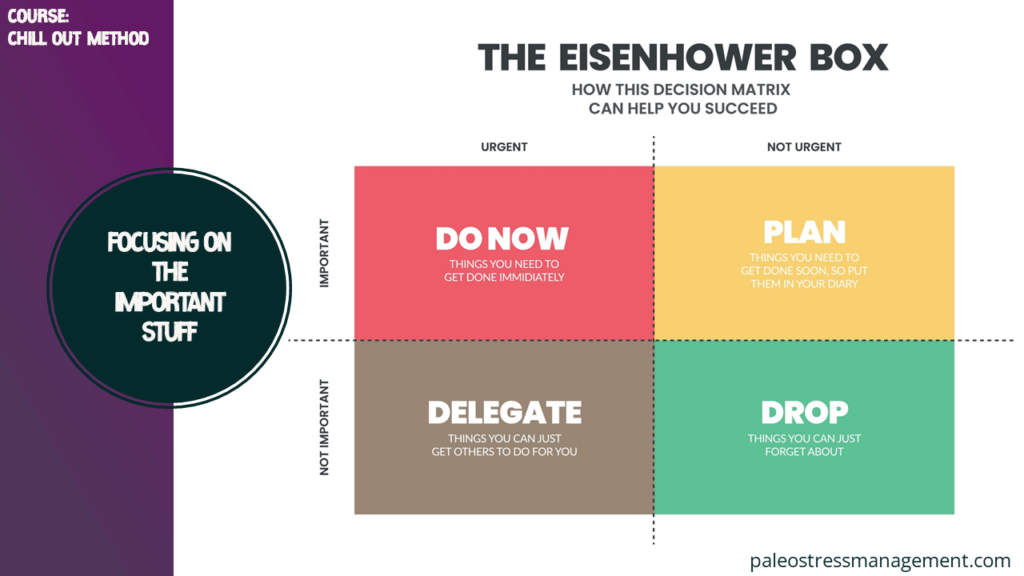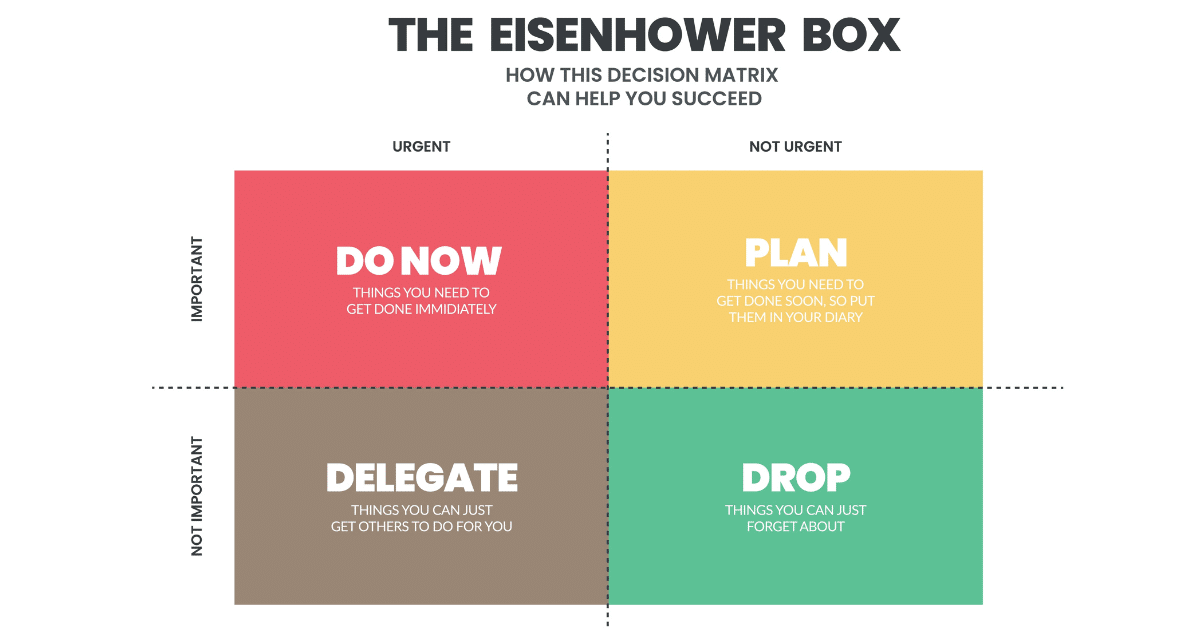The Eisenhower Matrix is a tool for sorting tasks by urgency and importance. It uses four categories to help you decide what to do first, making it easier to manage your time and get things done efficiently 1.
How does the Eisenhower Matrix help manage tasks?
The Eisenhower Matrix categorizes tasks into four quadrants based on urgency and importance. This helps users prioritize effectively, focusing first on urgent and important tasks and then on important but not urgent ones, reducing time spent on less critical activities.
This blog is part of a series on “time management.” The next blog is about the time-blocking method.
Key Benefits of Using the Eisenhower Matrix
- Improves focus by categorizing tasks into manageable quadrants.
- Enhances decision-making skills by identifying urgent versus important tasks.
- Reduces stress and overload by clarifying priorities.
- Increases productivity by minimizing time spent on non-essential tasks.
- Facilitates delegation of tasks that are urgent but not important.
- Supports long-term planning by highlighting tasks that are important but not urgent.
- Helps build a habit of regular task review and adjustment.
The Basics of the Eisenhower Matrix
The Eisenhower Matrix is a simple yet powerful tool for sorting tasks into four quadrants based on their urgency and importance. Picture a big square divided into four smaller squares. These are not just squares but your guide to mastering time management.

The top left is for urgent-important tasks—these are the do-it-now tasks. The top right holds the not urgent-important tasks, which are important but don’t scream for immediate attention. Think of it as your strategic reserve, saving energy for what truly matters without the rush.
| Quadrant | Urgency | Importance | Examples of Tasks |
|---|---|---|---|
| Urgent-Important | High | High | Meeting deadlines, Crisis management |
| Not Urgent-Important | Low | High | Planning, Relationship building |
| Urgent-Not Important | High | Low | Some calls, Most emails |
| Not Urgent-Not Important | Low | Low | Time wasters, Busy work |
The bottom left is for urgent-not-important tasks. These are distractions in disguise, often pretending to be pressing but not contributing to your goals. Finally, the bottom right is for not urgent-not-important tasks, essentially the junk drawer of your task list, rarely worth your attention.
Setting Up Your Eisenhower Matrix
Setting up your Eisenhower Matrix starts with a blank sheet, a pen, or an app or spreadsheet if you’re digitally inclined. Draw two lines to make four boxes, and label them for each category of urgency and importance.
Begin populating these boxes with your current tasks. Place each task where it belongs. Is it urgent and important? It goes into the top left. Important but not urgent? That’s the top-right material. This method helps you visualize what you should focus on, reducing the fog of a cluttered mind.
Regularly updating your matrix ensures it reflects the ever-changing landscape of your daily tasks. It’s like recalibrating your compass to ensure you’re still heading towards your true north of productivity. Keep it current, and it will guide you reliably.
Daily Task Management with the Matrix
Using the Eisenhower Matrix daily transforms it from a mere tool to a habit, embedding it into the fabric of your daily routine. Start each morning by reviewing your matrix and re-assessing what’s urgent and important. It’s like planning your route before a road trip, ensuring you don’t waste time on unnecessary detours.
As your day unfolds, keep the matrix handy. It will serve as your filter, helping you decide if new tasks are worth your immediate attention or if they can wait. This ongoing sorting acts like a gatekeeper, ensuring that only worthwhile tasks consume your valuable time.
End your day by preparing the matrix for the next. Shift tasks as needed based on their progress or any new information. This nightly ritual helps you hit the ground running the next morning, armed with a clear action plan.
Integrating Digital Tools with the Matrix
You can enhance your Eisenhower Matrix by integrating it with various digital tools in today’s digital world. These tools can automate the sorting of tasks based on predefined rules, like deadlines and project tags, making the process even smoother and more efficient.
Imagine your tasks automatically finding their place in the matrix when you define their importance and urgency in your digital task manager. This integration can be a real game-changer, allowing you to focus more on doing and less on planning.
Many apps also offer notifications to remind you of your priorities, ensuring that important tasks don’t slip through the cracks. It’s like having a personal assistant who’s always looking out for your best interests, keeping you on track without constantly checking your to-do list.
Common Pitfalls and How to Avoid Them
A common pitfall in using the Eisenhower Matrix is overfilling the urgent-important quadrant. It’s easy to fall into the trap of treating every task as a high priority, which can lead to burnout. To avoid this, take a moment to critically assess the true urgency and importance of each task.
Another mistake is neglecting the not urgent-important quadrant. These tasks are key to long-term success and should not be overlooked. Schedule regular times to review and advance these tasks, ensuring they progress and not just linger on your radar.
Lastly, avoid the temptation to ignore the matrix when overwhelmed. In those busy times, the matrix can be your best ally, helping you navigate the chaos with clarity and focus. Regularly consulting your matrix can be like finding calm in the storm, helping you stay on course no matter how rough things get.
Personal Thoughts
I found the Eisenhower Matrix invaluable in managing teams and high-stress jobs globally. It helped me prioritize tasks effectively, reducing the chaos that heightened my stress.
Applying this tool in personal crises also provided clarity and control, lessening my anxiety during turbulent times.
Frequently Asked Questions
How do you use the Eisenhower Matrix effectively?
To use the Eisenhower Matrix effectively, list all your tasks and then categorize each into one of four quadrants: urgent and important, not urgent but important, urgent but not important, and neither urgent nor important. Focus primarily on tasks in the first two quadrants to manage your time better.
Can the Eisenhower Matrix be used for team management?
Yes, the Eisenhower Matrix can be adapted for team management by categorizing tasks based on their importance and urgency for the team’s objectives. It helps managers prioritize projects and delegate tasks efficiently, optimizing critical deadlines and resources.
What differentiates the Eisenhower Matrix from other prioritization tools?
Unlike other prioritization tools, the Eisenhower Matrix distinguishes tasks not only by urgency but also by importance. This dual-focus approach prevents important tasks from being overlooked in the rush to handle urgent matters, fostering a more balanced and strategic approach to time management.




